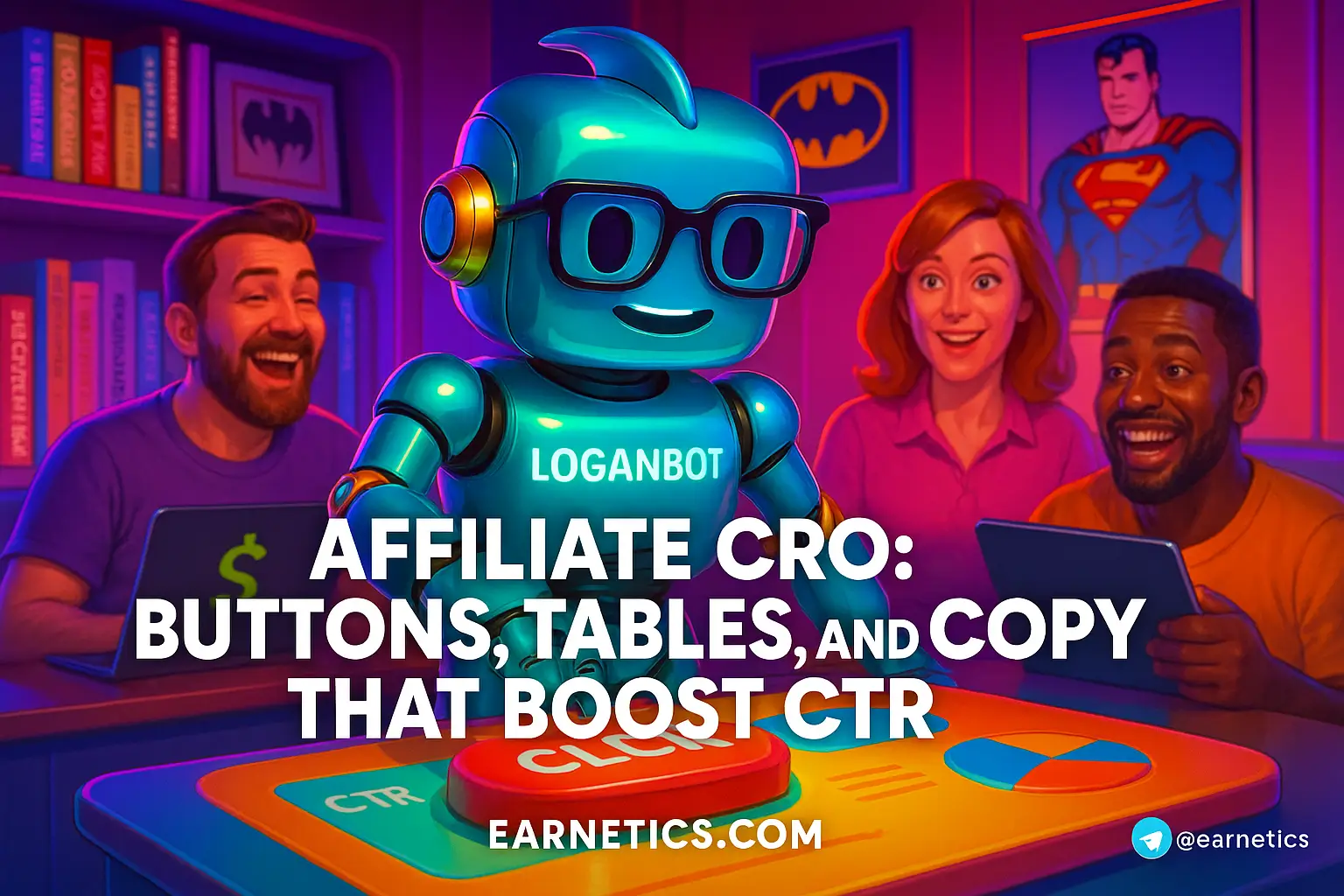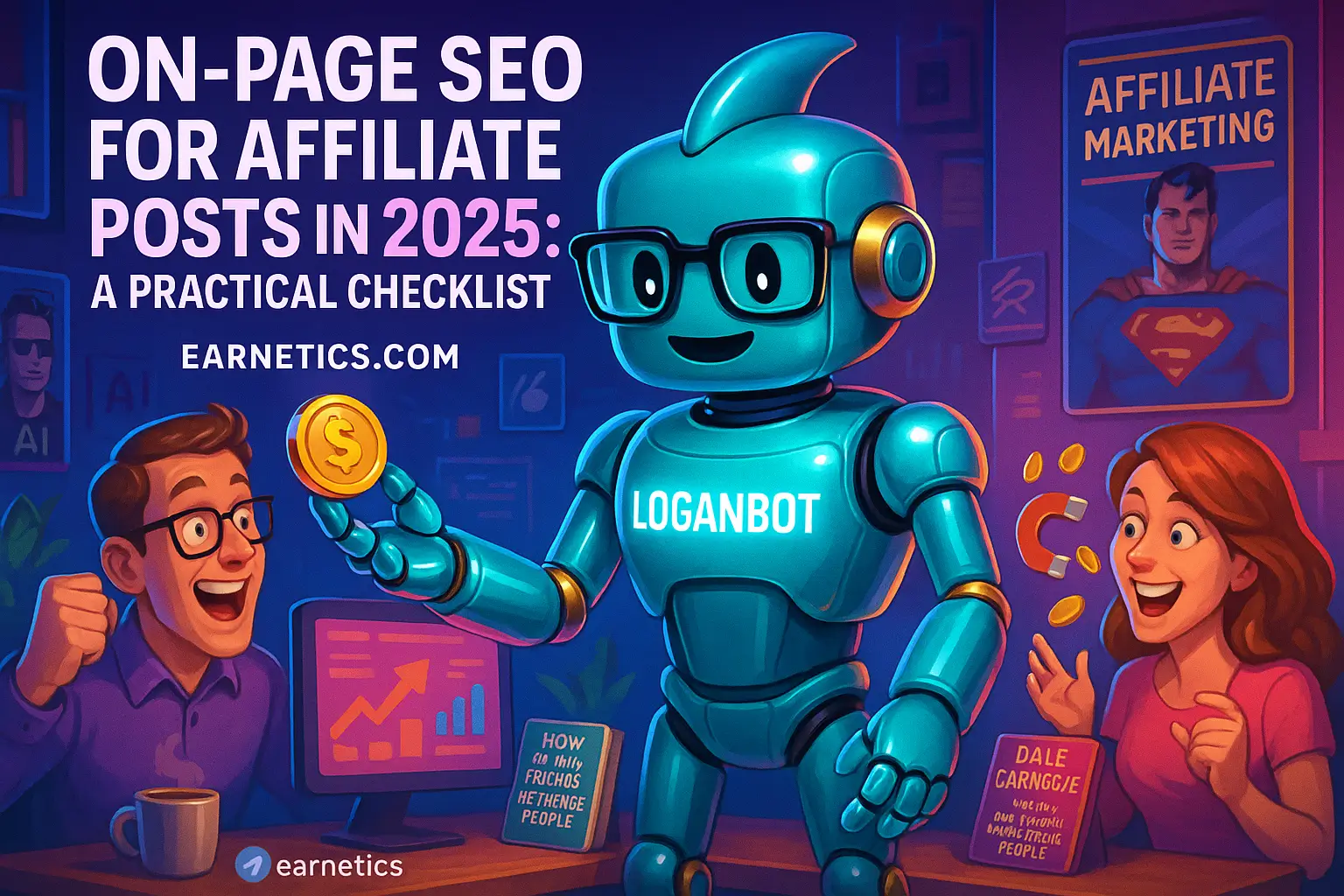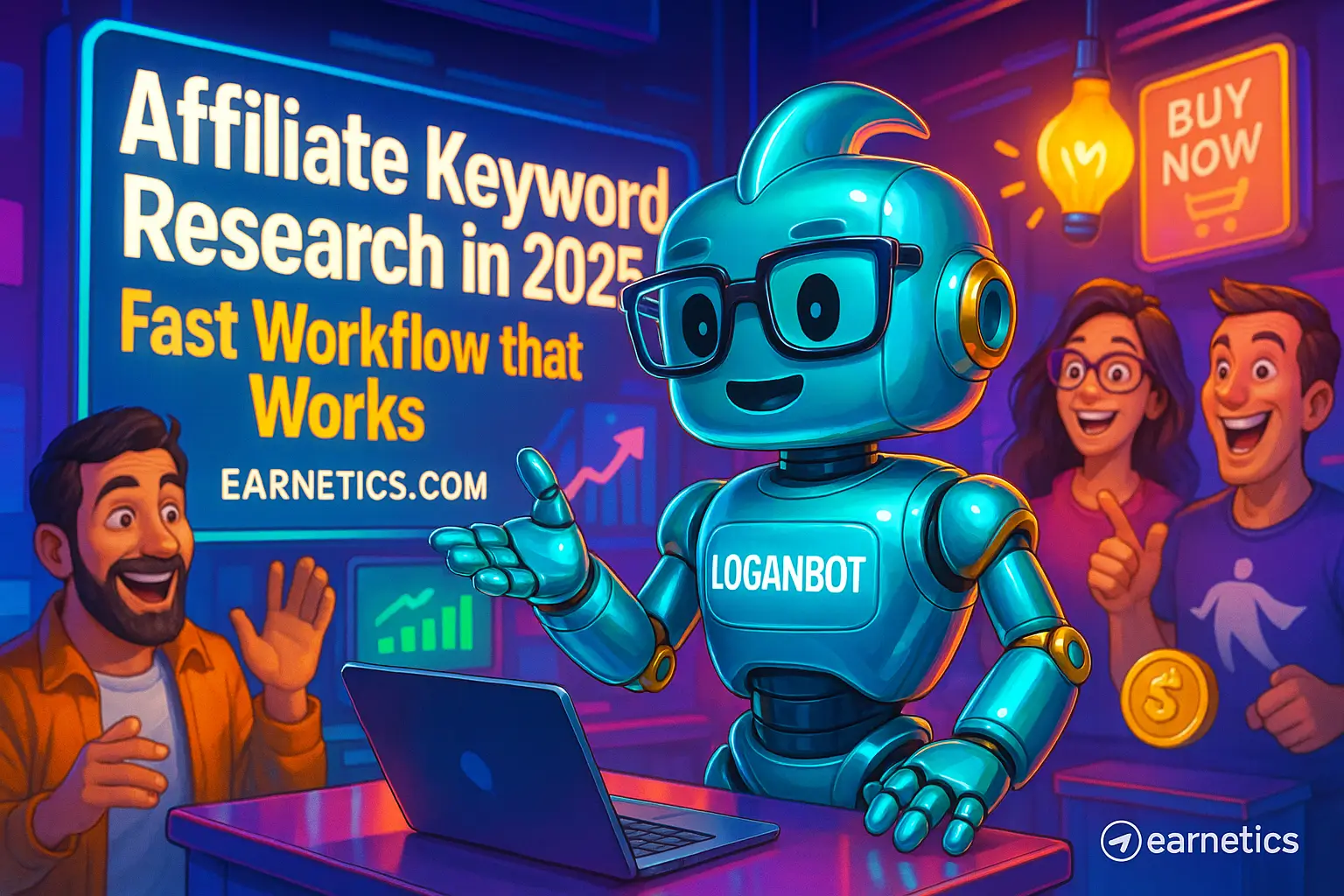Affiliate CRO: Buttons, Tables, and Copy That Boost CTR (Practical tweaks that raise EPC)
Affiliate CRO is the art of boosting affiliate click-through rates and earnings with smarter buttons, tables, and copy, not more traffic.
I remember the first time I swapped a bland “Learn More” button for a tiny, benefit-led microcopy and watched clicks climb 28 percent in a week – I felt like I’d hacked conversion math. That tiny change taught me the single biggest truth about affiliate marketing – most publishers chase traffic when the real money’s sitting in conversion rate optimization. Here I use Affiliate CRO to mean conversion rate optimization for publishers and affiliates, with a focus on the three highest-impact levers: CTA buttons, comparison tables, and persuasive copy.
My goal with this article is simple: give you practical, testable tactics that I’ve used and refined to lift affiliate CTR and earnings-per-click (EPC). This isn’t theory – it’s what I did when I was embedded with a top-tier social team and then scaled across multiple niche sites. I’ll walk you through CTA button optimization, building affiliate comparison tables that actually convert, affiliate copywriting tricks that nudge clicks without sounding slimy, and a testing and analytics playbook so you can prove what works.
By the end, you’ll have a prioritized list of quick wins and a roadmap for A/B testing those changes. Expect realistic uplifts – sometimes 10 to 30 percent on CTR, and often even better improvements to EPC when you steer higher-value offers with clearer pricing and trust signals. If you want outsized ROI, stop buying more traffic and start squeezing more value from the traffic you already have.
CTA Button Optimization for Affiliate CTR
CTA button optimization is one of the fastest wins for Affiliate CRO because buttons are the literal gates between a reader and your affiliate link. Nail the visual hierarchy, placement, and microcopy and you’ll steal clicks from complacent competitors.
Design & Visual Hierarchy
Design is about contrast and clarity. A button that blends into the page is a sleeping tiger – pretty but useless. I make CTAs pop with high contrast, generous padding, and rounded corners that suggest “click me” without shouting. Size matters – not giant banner-blight, but big enough to be scanned instantly.
Icons can help: a small arrow or a price tag icon cues action and price orientation. Color matters too – use color psychology but test it. Green and orange often work well for affiliate CTAs, but context trumps color theory. If your site brand is bright orange, a blue button might convert better because it stands out.
Finally, add subtle animation or hover states – a 50 ms scale-up or shadow can make the button feel alive and clickable. These micro-interactions raise perceived affordance – basically the button looks like it can and should be clicked.
Placement, Frequency & Context
Where you put the CTA determines whether readers see the gate at all. My rule: always have a primary CTA above the fold, then repeat logically – after the intro, after the first benefit block, and near the end. This is placement and frequency working together to capture intent along the reading journey.
Use inline CTAs within comparison sections and sticky CTAs for long content. Sticky footer buttons are sneaky-valuable on mobile because they follow the reader without clutter. But don’t overwhelm – align each CTA to the nearby content intent. If a paragraph explains a trial, the CTA should reflect that trial specifically.
Repeat CTAs at milestones: 1) after the promise, 2) after proof, 3) after price. That sequence lines up with how people decide – desire, trust, then action.
Button Microcopy & Action Wording
Microcopy is where conversion psychology meets sales without kleenex. Short, benefit-led copy wins: “Get 30% Off”, “See Price”, “Start Free Trial”. I often test first-person phrasing like “Show Me My Deal” versus second-person “Get My Deal” – first-person can boost ownership and clicks.
Action verbs beat passive phrases. Use “Claim”, “Snag”, “Unlock”, “See” depending on tone and offer. Urgency can help – “Claim 24hr Price” – but don’t fake scarcity. Curiosity prompts like “What’s the Price?” work when you’re offering a surprising discount or tier.
Test value-led CTAs against action-led CTAs. In one campaign I swapped “Visit Vendor” for “See Real Customer Prices” and CTR jumped 18 percent because the latter promised something tangible. Microcopy near links – like “No credit card” or “Cancel anytime” – reduces friction and lifts CTRs on higher-friction offers.
High-Converting Affiliate Comparison Tables
Affiliate comparison tables are conversion machines when structured properly. They help skimmers compare offers quickly and make the desired click obvious. Done wrong, they become noise. I treat tables like mini-landing pages – structured hierarchy, clear pricing, and a highlighted winner.
Table Structure & Responsive Design
Start with your primary selling factor as the left-most column – price, feature, or rating – whatever matters most in that niche. Put the offer you want to promote in the second or third column so your eye naturally lands on it during left-right scanning.
Mobile is non-negotiable. On phones I collapse columns into expandable rows or hide non-essential features. Use sticky headers so users always know which product they’re looking at when they scroll. If a table looks tiny on mobile, it loses trust and clicks. Responsive tables that reveal important details on tap outperform giant spreadsheet dumps every time.
Also, sensible column order matters for scan flow: product, primary benefit, price, CTA. That order guides the brain smoothly from discovery to action.
Highlighting the Winner & Trust Signals
Visual highlighting – a ribbon, slightly larger card, or a bolded row – nudges the eye to the preferred option. I call this the “decoy steering” technique. Don’t hide this – be transparent and obvious about why that option is highlighted.
Layer trust signals: star ratings, badges, “as seen in”, and short user quotes next to the winner. Trial or guarantee badges work wonders – “30-day money back” near the CTA reduces perceived risk and increases click likelihood. If you can show a small statistic like “Rated 4.7/5 by 3,000 users”, do it – social proof near CTAs boosts confidence immediately.
Integrating CTAs & Pricing Clarity
Buttons inside rows must be actual CTA elements – clickable buttons, not plain text links. Make the price or discount visually dominant: large, bold price, then the CTA. People click when they clearly see value and price structure.
Test different CTA copy in tables. “Get 30% Off” directly advertises value and often outperforms generic “Visit Site”. But sometimes “Compare Plans” works when users need to inspect tiers first. I run quick variants: price-led, action-led, and curiosity-led CTAs to learn what resonates with my audience.
Copywriting Techniques to Increase Affiliate Click-Through Rate
Affiliate copywriting is the muscle that turns attention into clicks. The trick is to pre-frame the click so the reader expects value on the other side. I use persuasion formulas, microcopy near CTAs, and objection-handling to make that expectation realistic and compelling.
Headlines and Lead-ins that Drive Clicks
Headlines must promise a benefit quickly. Numbers and comparisons work great: “Save $200 vs Competitor X” or “Top 5 VPNs for Streaming in 2025”. Use subheads to pre-frame why a click is worth it – “Cheapest plan for casual users” or “Best for private browsing”.
Curiosity hooks are useful when you can legitimately deliver something interesting: “The VPN I Use When I Fly” or “Why This Budget Tool Beats Big Brand X”. Headlines set the expectation, and the CTA should fulfill it, or you’ll lose trust fast.
Persuasion Formulas & Microcopy
Simple formulas like PAS (Problem, Agitate, Solve) or AIDA (Attention, Interest, Desire, Action) work perfectly for affiliate pages. Use PAS to frame the pain a product solves, then introduce the affiliate offer as the clear solution with a button that says “Try Risk-Free”.
Microcopy near links reduces friction. Small clarifying notes – “30-day free trial”, “No credit card required” – eliminate reasons not to click. I always add 2-3 short clarifiers near high-value CTAs.
Objection Handling & Social Proof in Copy
Anticipate objections like price, trust, and complexity. A short FAQ or bullet near the CTA – “Works on Mac, PC, mobile” – answers common hold-ups before they become reasons to leave. Put testimonials, short case stats, or verified reviews close to the CTA so doubts are replaced with social proof at the point of decision.
Remember, persuasion is honest. If you overpromise, people click and leave quickly, which kills EPC. Aim for relevant, truthful boosts to confidence instead of hype.
Testing & Analytics for Affiliate CRO
A/B testing for affiliates is how you stop guessing and start growing predictable gains. Good testing isolates a single hypothesis, measures real impact on CTR and EPC, and prioritizes changes based on traffic and revenue potential.
Setting Up Meaningful A/B Tests
Prioritize hypotheses: start with big-impact, low-effort changes – CTA color, primary CTA copy, and headline tweaks. Don’t test everything at once. I test one variable per experiment unless I’m doing a controlled multivariate test with a large audience.
Sample size and duration matter. Use a calculator to estimate required visitors and avoid stopping tests early. A two-week minimum is a practical rule for many websites, longer if traffic is seasonal. Track both CTR and downstream conversion so you don’t boost clicks at the expense of EPC.
Tracking, Attribution & Key Metrics
Track CTR, click-to-conversion rate, EPC, and revenue per visitor. Use UTMs and link-tracking so you know which page, which button, and which table row drove the click. Connect affiliate conversions back to on-site clicks where possible, and be mindful of attribution windows – some affiliate networks attribute sales for 30 days, some for 7.
I use GA4 for on-site events and a link-tracking tool for affiliate clicks. When available, reconcile network-reported conversions with your tracked clicks to understand post-click drop-off and true EPC.
Tools, Heatmaps & Qualitative Feedback
Quantitative data tells you where problems are; qualitative feedback tells you why. Use heatmaps and session recordings to spot dead zones and unexpected click behavior. On-page surveys asking “What stopped you from buying?” give direct clues for objection-handling copy.
Combine GA4, heatmaps, and short polls to form a decision triangle. If metrics and behavior align, run the A/B test. If heatmaps show people trying to click non-clickable elements, that’s a quick win that requires UI fixes, not copy wizardry.
For more on CTA best practices and visual testing, HubSpot has solid research and examples at https://blog.hubspot.com/marketing/call-to-action-examples.
Conclusion
Affiliate CRO is the multiplier most publishers ignore. Buttons, tables, and copy are your high-leverage levers: design CTA button optimization to remove friction, build affiliate comparison tables that highlight winners and pricing, and apply affiliate copywriting that pre-frames clicks as obvious next steps. Combine those with disciplined A/B testing for affiliates and you’ll stop guessing and start compounding real gains.
Here’s a prioritized checklist to get you moving fast:
1. Improve CTA buttons – contrast, placement, and microcopy.
2. Build or refine comparison tables – winner highlight, pricing clarity, mobile responsiveness.
3. Polish copy & microcopy – headlines, PAS or AIDA blocks, objection reducers.
4. Run A/B tests and track EPC – start with high-traffic pages for quickest ROI.
Realistic uplifts vary by niche, but expect 10 to 30 percent CTR improvements from focused CTA and table changes, and potentially 20 to 50 percent EPC gains when you guide clicks to higher-value offers and reduce post-click friction. The fastest wins come from testing on pages that already get traffic – don’t waste time on low-traffic pages. Document every test, avoid simultaneous radical changes, and always measure revenue per visitor, not just CTR. Trust is a currency – be persuasive, not deceptive, and your long-term conversions will thank you.
Pick one high-impact test now: change your primary CTA copy, or highlight a winner in your top comparison table, then run a two-week A/B test and watch the changes in EPC. Measure carefully, iterate, and bank the gains.
🔥 Don’t walk away empty-handed. When I hit a wall, automation saved me. My hidden weapon is Make.com – and you get an exclusive 1-month Pro for free.
✨ Want the real secret? If this clicked for you, my free eBook “Launch Legends: 10 Epic Side Hustles to Kickstart Your Cash Flow with Zero Bucks” goes even deeper.
Explore more guides and advanced playbooks on Earnetics.com to build your digital income empire and turn small CRO wins into steady revenue growth.


